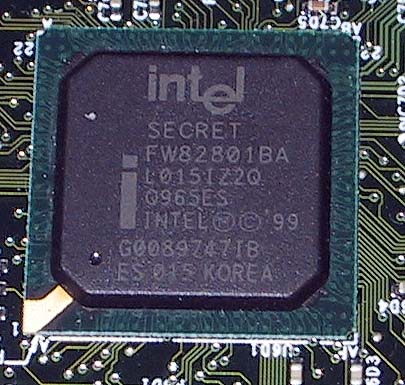Intel i815 / i815E Motherboard Roundup - August 2000
by Mike Andrawes on August 3, 2000 5:25 AM EST- Posted in
- Motherboards
The i815 is actually available in two different flavors - the "standard" i815 and the i815E. The only difference between these two is the ICH model that is included on the board, and of course the features associated with these two chips. The differences are few, but significant. You can identify whether you have an i815 or i815E by looking at the ICH on your board - the i82801BA is the ICH2 used on the i815E and the i82801AA is the original ICH found on the "standard" i815. Don't be fooled when you're buying an i815 board - the differences in the I/O Controller Hub may not make much difference to you, but make sure you know what you're getting.

Both models connect to the GMCH via Intel's Hub Architecture (IHA), formerly known as Accelerated Hub Architecture (AHA). Both support 6 PCI slots, AC'97/MC'97 CODEC's, and USB 1.1. Both require an external PCI-ISA bridge for a motherboard to support ISA slots.
The most obvious feature that the i82801BA ICH2 offers over the i82801AA ICH is Ultra ATA/100 support. While hard drives are still not really pushing Ultra ATA/66, this is definitely a feature that will show its value in the future. IBM's Deskstar 75 GXP and just about every hard drive released in the near future will support Ultra ATA/100, even though none of those drives can sustain even Ultra ATA/66 speeds.
The next obvious feature is support for 2 USB root hubs, for a total of four ports, instead of 1 USB root hub/2 ports. Contrary to some early rumors, ICH2 does not support USB 2.0 - we'll have to wait a little while longer to get USB 2.0 support. Note that most motherboards require an extra bracket to take advantage of the second set of USB ports, which may or may not be included with your motherboard depending on the manufacturer and even what your vendor orders.
With the ICH2, Intel also introduced the CNR standard that expands upon the AMR standard they introduced with the original ICH on the i810/i820. CNR slots allow you to take advantage of the Intel i82559 ethernet controller integrated on the ICH2 chip. That ethernet controller can be configured as either a 10/100 ethernet or HomePNA 2.0 controller as well, depending on the CNR card used. This is of course perfect for the increasing existence of broadband and the need for networking in the home.
Unlike AMR, CNR could end up becoming a very useful feature for AnandTech readers – if CNR cards become readily available online. So far, CNR cards are still tough to find, but it's definitely not impossible. Fortunately, motherboard manufacturers are designing their boards so that the CNR slot is shared with a PCI slot, meaning that the PCB space isn't "wasted" as many users viewed AMR slots.
The AC'97 support has been improved from 2 channel to 6 channel on the ICH2, although this really makes little difference for most AnandTech readers that will simply disable the host-based audio in favor of a "real" hardware-based sound solution.
With that said, let's take a look at what to look for in an i815 motherboard.










0 Comments
View All Comments